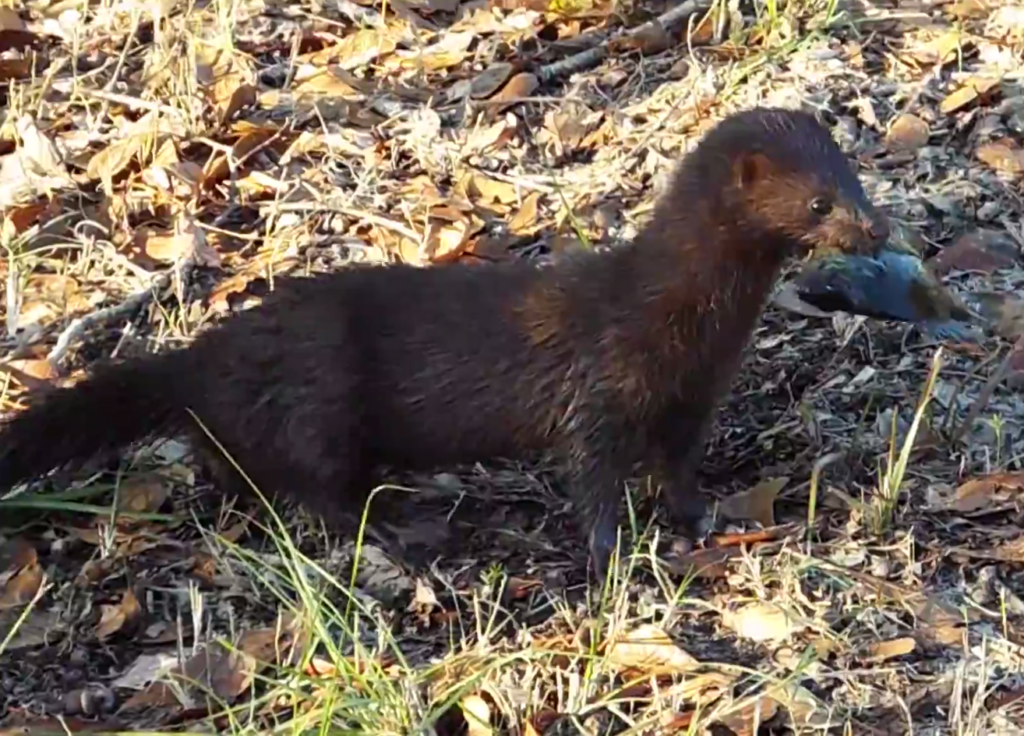



This week for Flora and Fauna Friday we’re talking about: the American Mink (Neovison vison).
Minks are members of the Weasel family, Mustelidae. We have three species of Mustelid in our area: the Long-tailed Weasel, the North American River Otter, and the American Mink. (We’ll likely touch on Otters another time.) The American Mink is found throughout the United States and Canada, excepting the Southwestern US. There are currently 15 recognized subspecies. Here in coastal SC, our one subspecies is the Atlantic Salt Marsh Mink (Neovison vison lutensis).
Our Mustelids are characterized by their long, slender bodies, short legs, and agile movements. Mink have a thick, fluffy, chocolate-brown coat, white chin, small ears, and thick tail. They can get up to two and a half feet in length, with the tail making up about a quarter of that. You’re most likely to see them at dawn or dusk, hunting on the edges of ponds and marshes. On land they move with a playful bounding and they are quite agile underwater. Mink are solitary animals and only interact during their breeding season. They live in burrows on river banks or berms.
Like most Weasels, Mink are fearless predators. They will attack anything that strikes their fancy including: fish, crustaceans, sea birds, rats, ducks, squirrels, chickens, frogs, and even snakes. The one in my photos below caught a Shellcracker, or Redear Sunfish, from a freshwater pond and was taking it back into the saltmarsh to eat. They will hunt in a variety of habitats including: burrows, fields, ditches, marshes, forests, rivers, ponds, and they’ll even climb trees. Don’t let their cute appearance fool you, Mink are ruthless. Weasels don’t use ambush tactics like other mammal predators, they charge their prey head on. Mink with their soft fur, large feet, short legs, and slender body have a stealthy approach. Their feet and fur dampen the noise they make on brush during their approach, masking their size. Their short legs and slender body keep them low to the ground and out of sight while allowing them to squeeze through rocks, roots, and into tunnels while in pursuit. Counterintuitively, the constant subtle noises they make when approaching fools their prey’s instincts into thinking the Mink is not a threat until it’s too late to react. This is because most predators are much heavier than a Mink and make as little noise as possible when stalking prey until using a sudden burst of speed to close the gap. Upon capturing prey, Mink grab their prey by the back of its neck while holding onto its back with their feet. They control the struggle with their serpentine bodies while they try to sever the animal’s spinal cord. Mink often kill more prey than they can ever hope to eat and will store the leftovers for later. This can give them a terrible reputation with anyone who maintains a chicken coop, as they can kill an entire flock overnight and not eat a single bird.
Mink have also been semi-domesticated. These domestic breeds are used in fur farming or as a hunting companion. In some regions, Mink are commonly used as ratters instead of cats or terriers and are trained to hunt Muskrats. The domestic breeds not only retain their ruthless hunting instincts but are even more fearless than their wild cousins.